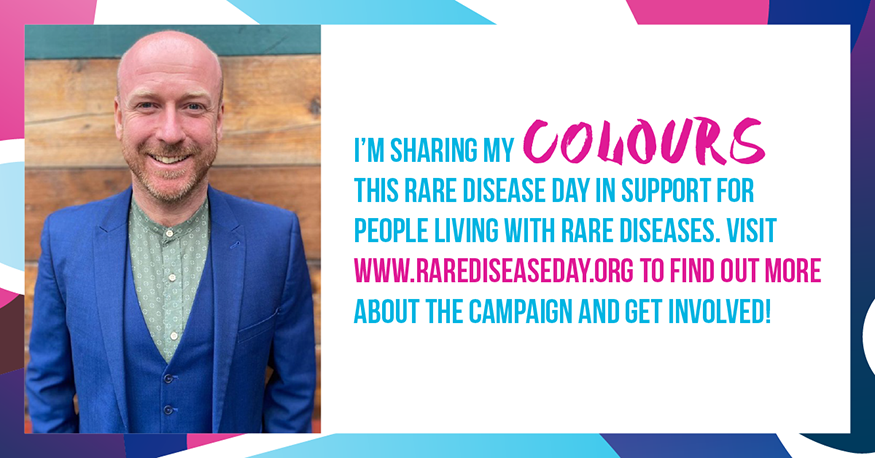Why I’m proud to share my colours for Rare Disease Day

Disease affects us all at some stage in our life. Whether you fall ill yourself, or need to care for a loved one, it is unavoidable.
28th February marks Rare Disease Day – organised by the European Rare Disease Organisation (EURORDIS), it’s a chance to raise awareness and generate change for people living with rare diseases, their families and caregivers. During my two and a half years as Janssen EMEA Medical Director for Pulmonary Hypertension, I was privileged to be able to help contribute to these goals. In that time, we have been able to further the clinical research activities which will contribute to the future of PH treatment strategies.
Not as rare as you might think
The European Union considers a disease as ‘rare’ when it affects fewer than 1 in 2,000 citizens. Although these numbers sound small, the number of rare conditions means an estimated 30 million people in Europe and 300 million worldwide are affected by a rare disease.1
One of the rare diseases Janssen works to support is pulmonary arterial hypertension (PAH), a progressive and potentially life-threatening condition that affects the blood vessels that carry blood from the heart to the lungs. Over time, these vessels become narrower and less flexible, restricting blood flow to the lungs and making the heart work harder to maintain the blood flow. This increased workload can lead to right heart failure.2,3
An unsettling diagnosis
Diagnosing a rare disease is challenging. A survey by EURORDIS of eight relatively common rare diseases in Europe showed 25% of patients waited 5-30 years for a diagnosis, and during that time 40% received an incorrect diagnosis.4 Misdiagnosis results in inappropriate treatment and care options.5
These challenges are acutely observed in PAH. Delayed diagnosis, due in part to lack of awareness, means that many PAH patients have severe disease when diagnosed.6 This is compounded by the fact that 5-year survival for previously diagnosed patients with the most severe form of PAH (WHO functional class IV PAH) is just 27%.7 I have written previously about the challenge of diagnosing and treating PAH - read more here if you're interested.
Given the rarity and severity of PAH, a diagnosis can be scary and very unsettling for patients. Imagine being diagnosed with something you have never heard of before! At Janssen, we are trying to shorten the time to diagnosis, by recognising connections with other diseases, developing innovative digital and educational tools to support PAH screening and diagnosis, and raising awareness among healthcare professionals involved in the PAH referral pathway. If you want to read more, check out my colleague Jason’s article on the links between PAH and scleroderma here. Janssen’s PAH patient empowerment campaign, 'Breathe In, Speak Out', and our PAH information portal, PH Human, also provide vital information and real-life stories for people living with PAH. We want them to know they are not alone.
The task ahead
I am inspired by the significant task ahead of us. We are making big strides in harnessing new technology, improving treatment and empowering patients, but we still have a long way to go. Many patients are diagnosed too late and this needs to change. As a company, we are committed to transforming PAH into a long-term, manageable condition so that patients can live a normal life.
I’m grateful to be part of an organisation that focuses on the needs of people living with rare diseases like PAH, despite the rarity of the conditions. You may have noticed that I have recently taken on a new role as EMEA Medical Affairs Director, Early Portfolio. Despite the change in my job title, I am looking forward to continuing collaborations with colleagues across all the Janssen Therapy Areas, including rare diseases, and my passion and dedication to improve outcomes for people living with rare diseases remains.
Sharing my colours
The focus today though is not on me, but on the many people living with rare diseases. Days like Rare Disease Day are extremely important moments to amplify the voices of PAH patients and make them heard. I’m proud to ‘Share My Colours’ – I encourage you to do the same!
+++
References
[1] European Rare Disease Organisation (EURORDIS): What is a rare disease? Available at: https://www.eurordis.org/content/what-rare-disease Last accessed: February 2022.
[2] National Organisation of Rare Diseases (2019), Rare Disease Database: Pulmonary Arterial Hypertension, Causes. Available at: https://rarediseases.org/rare-diseases/pulmonary-arterial-hypertension Last accessed: February 2022.
[3] Humbert M, O’Callaghan D, Pulmonary arterial hypertension factsheet, European Lung Foundation, Available at: https://europeanlung.org/en/information-hub/factsheets/pulmonary-arterial-hypertension Last accessed: February 2022.
[4] European Rare Disease Organisation (EURORDIS): Survey of the delay in diagnosis for 8 rare diseases in Europe (‘EurordisCare2’). Available at: https://www.eurordis.org/publication/survey-delay-diagnosis-8-rare-diseases-europe-%E2%80%98eurordiscare2%E2%80%99 Last accessed: February 2022.
[5] European Rare Disease Organisation (EURORDIS): Undiagnosed rare diseases. Available at: https://www.eurordis.org/content/undiagnosed-rare-diseases Last accessed: February 2022.
[6] Prins KW, et al. Cardiol Clin 2016; 34(3):363-74.
[7] Farber H, et al. Chest 2015; 148:1043-54.


